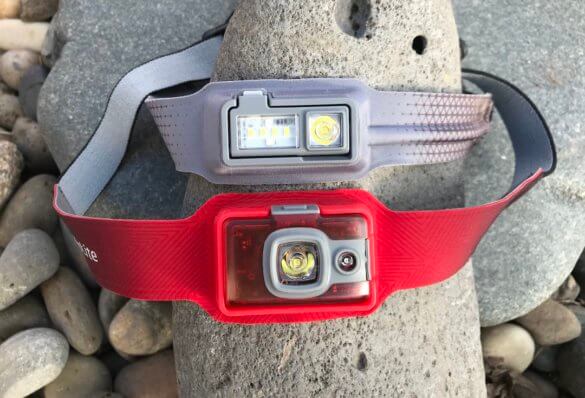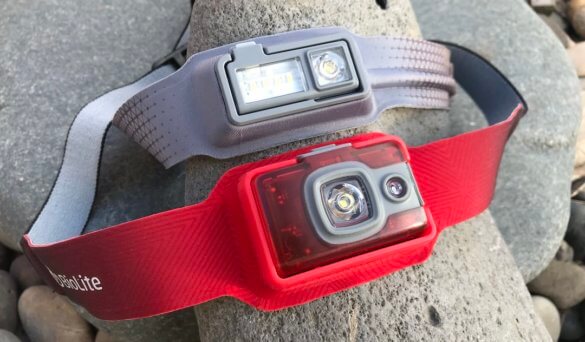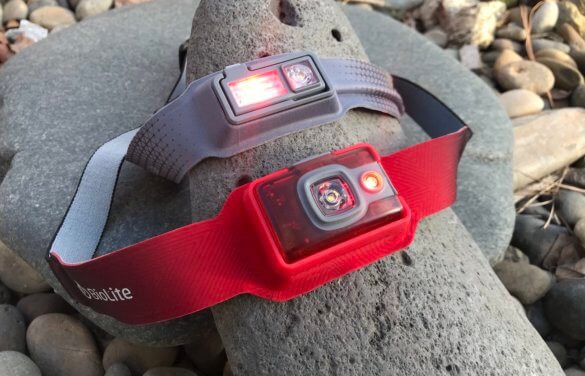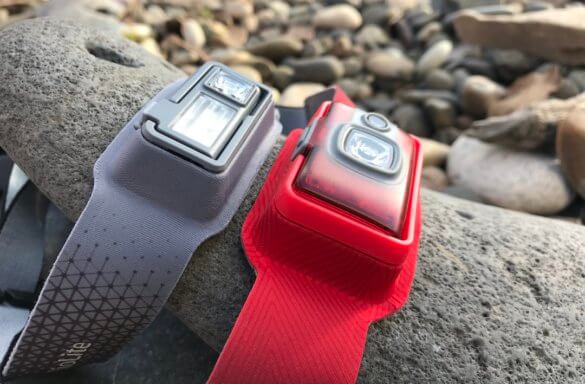BioLite now offers two similar lightweight, rechargeable headlamps, the HeadLamp 200 and HeadLamp 330. Both are super comfortable, but is the more powerful HeadLamp 330 better than the 200?
*Editor’s Update: BioLite has updated its headlamp line. Read our full review of the BioLite HeadLamp 325 here.
To get us a closer look at the HeadLamp 200 and 330, BioLite sent Man Makes Fire review units. This is what we learned:
BioLite HeadLamp 200 vs 330: Form Factor
Both BioLite HeadLamps feature an ultra comfortable headband. The headbands are fused to the headlight housing, which has a slight curve that fits most foreheads.

The key difference is the location of the rechargeable battery: The HeadLamp 200 (full 200 review) has the battery built into the housing while the HeadLamp 330 (full 330 review) has a separate battery attached to the rear of the headband.
You might think that the 330’s battery might feel heavy back there, but it doesn’t. It’s barely noticeable. On the other hand, does the larger headlight housing feel heavy on your forehead or bounce when running or jogging? Nope. It is ultralight and also retains a relatively low profile.
Both the HeadLamp 200 and 330 stay put and feel comfortable, even when you’re very active out on the trail.
There is one edge for the HeadLamp 200: If you like to read while laying back in your tent, you might appreciate not needing to adjust your pillow and angle to avoid the rear battery on the HeadLamp 330.
Lumens and Useable Light Output
Lumens are basically an indicator of the intensity of the light produced — more lumens generally means more light output. So on paper, the 330-lumen model should outperform the 200-lumen model, right? Yes, but it’s not quite that simple.

First, at full power, the 330 is brighter than the 200. In addition, its spotlight beam reaches out farther than the 200: The 330 can light out to about 75 meters while the 200 goes out to 50 meters or so. However, the spotlight beam on the 330 is actually a 230-lumen beam . . . and the wide floodlight is a 100-lumen beam. Both beams together result in the 330-lumen rating.
You can drive yourself nuts working through the mathematics of what the actual performance percentages should be, but it won’t really matter because the key factor is the quality and design of the optical components — how the reflecting elements and lenses direct the light emitting from the LEDs into something a human can use in the dark. Cheap headlamps and flashlights do a terrible job no matter what the lumen ratings are — the light is scattered and often has dark spots in it. So quality headlamps and flashlights are better than low-quality ones.
Both the HeadLamp 200 and 330 deliver surprisingly great beam patterns. The light is very clean and crisp. Surprisingly great, actually.
The HeadLamp 200 has just a single white output mode — it’s dimmable, of course, but it blends a spotlight with a floodlight. The result is a wide and full beam that also does a good job out to about 50 yards.
The HeadLamp 330 lets you choose between a spotlight or a floodlight — or both at the same time. In this respect, the 330 is more versatile in that it lets you fine-tune the performance for particular tasks.
Which is better? For general purpose use, we believe simplicity of the HeadLamp 200 is better for most people most of the time. For tasks around camp, it’s easy to dim the single beam to fit the need — or ratchet it up for extra power.
On the other hand, if you’re a serious trail runner moving quickly over rough terrain, you’ll probably want to error on the side of greater brightness.
Battery Life & Weight
The HeadLamp 200 has a 700 mAh rechargeable battery that lasts about 3 hours on high and 40 hours on low. The HeadLamp 330 has a 900 mAh battery that lasts for about 3.5 hours on high and 40 hours on low. Basically, the batteries end up producing light for about the same amount of time. However, you could likely dim the 330 to the essentially the same level of output as the 200 . . . and get a longer burn time. (More battery is still more battery here.)
Both headlamps also have red-light modes, which saves your night vision — and generally won’t spook animals in the dark.

The HeadLamp 200 weighs 1.75 ounces while the HeadLamp 330 weighs 2.43 ounces.
While the .68 ounce difference seems like a lot, in person both headlamps feel very light on your head, so the weight difference is minimal.
The HeadLamp 330 does feature a 4-light LED battery power indicator on the rear battery pack. This lets you know at a glance approximately how much battery life you have left. The HeadLamp 200’s battery indicator method is less precise: The light will flash green twice when you turn it off if it has more than 50% battery life left. Two red flashes means it has less than 50% life and four red flashes means it’s pretty much empty and needs recharged.
Oh, one more thing: Both headlamps have a water-resistance IPX4 rating, which means they can handle some light splashing or a bit of rain. (If you need extended usage in continuous rain or on-the-water environments, you probably want to error toward a heavier and less comfortable but fully waterproof headlamp.)

The Verdict: HeadLamp 200 vs 330
For most people, most of the time, the HeadLamp 200 offers the best overall user experience. It’s astoundingly lightweight and comfortable. The familiar form factor is super simple. While the lumen output isn’t the highest, the beam pattern is excellent and crisp. We’re big fans.
If, on the other hand, you’re very active on the trail or in challenging outdoor environments, error toward the HeadLamp 330. Either way, you can’t really go wrong — both headlamps feel great, have similar build quality, and deliver excellent light.
Get the Gear:


